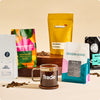What is Certified Organic Coffee?
Coffee beans with an organic coffee certification have not been grown with a chemical fertilizer or pesticide and were kept away from non-organic coffee beans during processing. It follows strict guidelines set by organic certification agencies to ensure environmentally friendly and sustainable farming practices.
What Does Organic Certification Mean for Roasters?
A USDA Certified Organic label also means a coffee’s roasting machine either doesn’t roast non-organic coffee, or goes through intense cleaning before and after roasting non-organic coffee beans.
Why should I choose certified organic coffee? Are there any health benefits?
Certified organic coffee not only benefits the environment but also your health. By avoiding harmful chemicals, organic coffee offers a purer, more natural taste while supporting sustainable agricultural practices. While more research is needed, some studies suggest that organic coffee may contain higher levels of antioxidants and beneficial compounds compared to conventionally grown coffee.
How can I ensure that the coffee I buy is truly organic?
Look for certifications from reputable organic certifying agencies, such as USDA Organic or Fair Trade. Additionally, purchasing from trusted sources like Trade Coffee ensures that your coffee meets rigorous organic standards and supports sustainable farming practices.
Is all organic coffee the same?
No, not all organic coffee is the same. Different regions, altitudes, and processing methods can impact the flavor profile of organic coffee. That's why it's essential to explore a variety of organic coffees to find your favorites- explore Trade's organic coffees today.
Organic Farming and Sustainability
Proponents of organic farming generally believe it to be better for maintaining healthy soils. Growing organic coffee can lead to better coffee plants in the short term and healthier farms in the long term, not to mention lowered risk of harmful chemicals from a pesticide or fertilizer affecting the environment around the coffee farm.
Switching to organic production can, at least in the short term, reduce yields for growing coffee, which can be a challenge to a farm’s economic sustainability. It’s important to remember then there isn’t just one type of organic farming, and one type of non-organic farming, so judging overall sustainability for an organic product is much more complex than having an organic label or no label.
The Importance of Organic Agriculture
While organic coffees have not been coated with synthetic pesticides, herbicides, and fungicides, the concern isn’t so much that those chemicals will make their way into a coffee lover’s morning drink. At temperatures above 450 degrees Fahrenheit, the roasting process most likely burns off any residual chemicals used when growing a coffee plant. The real question is what these harmful chemicals could do to the environment and communities where they are sprayed.
A Few Considerations for Coffee Lovers
Buying only certified organic coffee is certainly one of the ways a coffee lover can choose to shop with their values in mind. It should be noted, though, that organic production and certification cost a significant amount of money, so not every coffee farmer sees it as a wise investment to convert to an organic farm. And there are many farms that, though they follow practices that we understand as organic agriculture, don’t see the need to spend money on an organic certification for their coffee farm.









